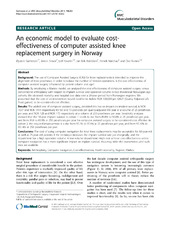| dc.contributor.author | Gøthesen, Øystein Johannes | en_US |
| dc.contributor.author | Slover, James | en_US |
| dc.contributor.author | Havelin, Leif Ivar | en_US |
| dc.contributor.author | Askildsen, Jan Erik | en_US |
| dc.contributor.author | Malchau, Henrik | en_US |
| dc.contributor.author | Furnes, Ove | en_US |
| dc.date.accessioned | 2013-09-11T13:18:31Z | |
| dc.date.available | 2013-09-11T13:18:31Z | |
| dc.date.issued | 2013-07-06 | eng |
| dc.Published | BMC Musculoskeletal Disorders 14(1):202 | eng |
| dc.identifier.issn | 1471-2474 | |
| dc.identifier.uri | https://hdl.handle.net/1956/7121 | |
| dc.description.abstract | Background: The use of Computer Assisted Surgery (CAS) for knee replacements is intended to improve the alignment of knee prostheses in order to reduce the number of revision operations. Is the cost effectiveness of computer assisted surgery influenced by patient volume and age? Methods: By employing a Markov model, we analysed the cost effectiveness of computer assisted surgery versus conventional arthroplasty with respect to implant survival and operation volume in two theoretical Norwegian age cohorts. We obtained mortality and hospital cost data over a 20-year period from Norwegian registers. We presumed that the cost of an intervention would need to be below NOK 500,000 per QALY (Quality Adjusted Life Year) gained, to be considered cost effective. Results: The added cost of computer assisted surgery, provided this has no impact on implant survival, is NOK 1037 and NOK 1414 respectively for 60 and 75-year-olds per quality-adjusted life year at a volume of 25 prostheses per year, and NOK 128 and NOK 175 respectively at a volume of 250 prostheses per year. Sensitivity analyses showed that the 10-year implant survival in cohort 1 needs to rise from 89.8% to 90.6% at 25 prostheses per year, and from 89.8 to 89.9% at 250 prostheses per year for computer assisted surgery to be considered cost effective. In cohort 2, the required improvement is a rise from 95.1% to 95.4% at 25 prostheses per year, and from 95.10% to 95.14% at 250 prostheses per year. Conclusions: The cost of using computer navigation for total knee replacements may be acceptable for 60-year-old as well as 75-year-old patients if the technique increases the implant survival rate just marginally, and the department has a high operation volume. A low volume department might not achieve cost-effectiveness unless computer navigation has a more significant impact on implant survival, thus may defer the investments until such data are available. | en_US |
| dc.language.iso | eng | eng |
| dc.publisher | BioMed Central | eng |
| dc.relation.ispartof | <a href="http://hdl.handle.net/1956/7597" target="blank">Computer Navigation in Total Knee Replacement Surgery. Effect on Outcome</a> | eng |
| dc.rights | Attribution CC BY | eng |
| dc.rights.uri | http://creativecommons.org/licenses/by/2.0/ | eng |
| dc.subject | Artrhroplasty | eng |
| dc.subject | Computer navigation | eng |
| dc.subject | Cost-effectiveness | eng |
| dc.subject | Health economy | eng |
| dc.subject | Register | eng |
| dc.subject | Markov | eng |
| dc.title | An economic model to evaluate cost-effectiveness of computer assisted knee replacement surgery in Norway | en_US |
| dc.type | Peer reviewed | |
| dc.type | Journal article | |
| dc.date.updated | 2013-08-23T08:38:16Z | |
| dc.description.version | publishedVersion | en_US |
| dc.rights.holder | Copyright 2013 Gøthesen et al.; licensee BioMed Central Ltd. | |
| dc.rights.holder | Øystein Gøthesen et al.; licensee BioMed Central Ltd. | |
| dc.identifier.doi | https://doi.org/10.1186/1471-2474-14-202 | |
| dc.identifier.cristin | 1045432 | |
| dc.source.journal | BMC Musculoskeletal Disorders | |
| dc.source.40 | 14 | |
| dc.source.14 | 1 | |
| dc.source.pagenumber | 202- | |

